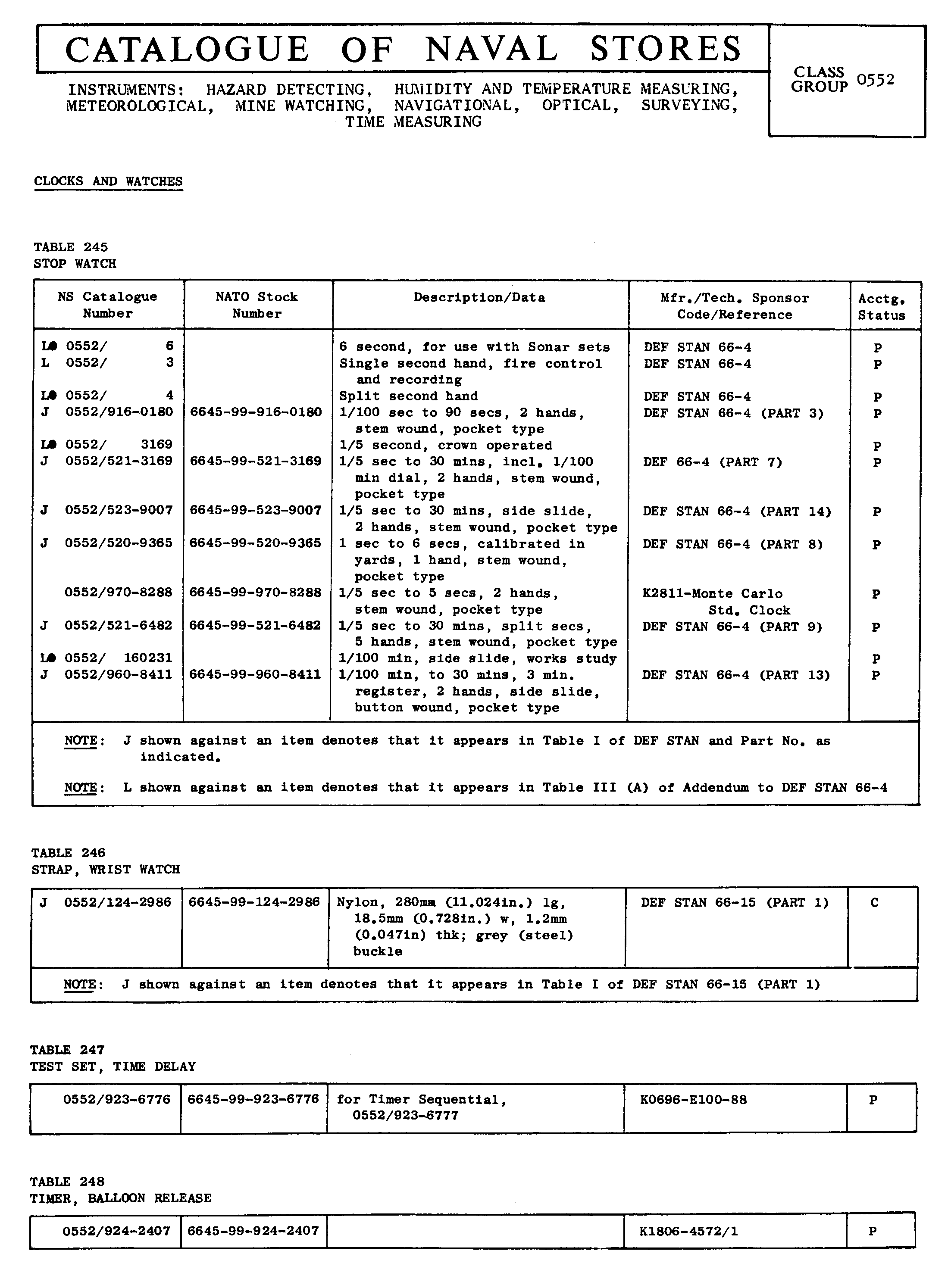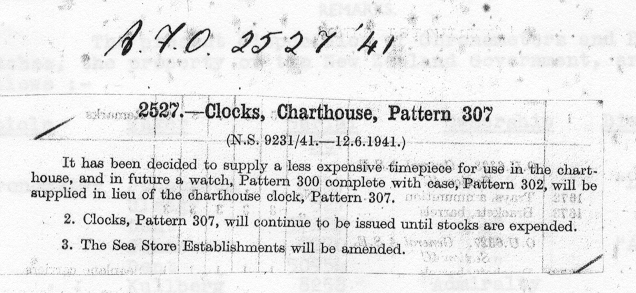
| WWT Shows | CLICK TO: Join and Support Internet Horology Club 185™ | IHC185™ Forums |

|
• Check Out Our... • • TWO Book Offer! • |
Welcome Aboard IHC185™  Internet Horology Club 185
Internet Horology Club 185  IHC185™ Discussion Site Main Page
IHC185™ Discussion Site Main Page  Horological Discussions, Questions and Answers
Horological Discussions, Questions and Answers  Military Timepiece Discussions - EXCLUSIVE!
Military Timepiece Discussions - EXCLUSIVE!  Admiralty Pattern timepieces
Admiralty Pattern timepieces
 Internet Horology Club 185
Internet Horology Club 185  IHC185™ Discussion Site Main Page
IHC185™ Discussion Site Main Page  Horological Discussions, Questions and Answers
Horological Discussions, Questions and Answers  Military Timepiece Discussions - EXCLUSIVE!
Military Timepiece Discussions - EXCLUSIVE!  Admiralty Pattern timepieces
Admiralty Pattern timepiecesGo  | New Topic  | Find-Or-Search  | Notify  | Tools  | Reply to Post  |  |
I raised the subject of Admiralty Pattern timepieces in another topic. The subject should really be dicussed in a topic of its owm. Having studied a number of files in the National archives of Australia, I have noted the following timepieces being referred to: AP3 AP4 AP6 AP10 AP30 AP119 AP201A AP210 AP221 AP300 AP301 AP305 Deck clock AP307 AP308 AP338 AP397 AP499 AP3169 These are often described as just "pattern 3" for example. If anyone has any more patterns to add to the list please do so. If you have documents that indicate their function and use, I would also like to hear about those as well. | |||
|
| Life Achievement Military Expert |
Hi Craig, Interesting original source data. I have not heard of anyone publishing anything about them before. Any idea of what sort of timepieces these codes represent? Thanks, Greg | |||
|
Having looked through the data I have collected while researching my AP3169. I located the following: AP3 Stop Watch, Single second, fire control and recording AP4 Stop Watch, Split second hand AP6 Stop Watch, 6 second, for use with Sonar sets AP302 Case, brass for watch 0552/308 (AP308) AP305 Clock, deck 8in. dial AP310 Clock, deck 8in. dial, 8 day, mechanically operated AP723 Clock, Saloon AP724 Clock, Marine, 6in. dial, 8 day lever AP725 Clock, dashboard for M.B. 25ft. and over AP727 Clock, 8 day, 8in. dial, marked 5-60 sec. AP811 Key, Clock AP1715 Clock, weekly AP2816 Key, Clock AP3169 Stop Watch, 1/5 second, crown operated This is from the Naval stores catologue, BR320. I do not know when this copy was published but I believe it to be in the 60's or 70's. References are made to certain Def Stan's. The earliest one mentioned was cancelled in Nov 1990. The BR320 is now electronic so I am lucky to have got my hands on this copy as it was only by the foresight of an old timer that the book was not destroyed when it was made obsolete. I was lucky to be shown out the back to look at them, when I showed interest to the right people who knew. It took me a year to get my hands on this, and at least 3 enquires to the location where it is, before I struck gold. It is interesting to note that these items were never codified. In other words not assigned a NSN. This could mean that this document is from the 50's or 60's. At that time the ABCSC system i.e. American British Canadian Supply Cataloguing System was in use. Experience of the armed forces in World War 2 emphasised the necessity for a single identification system for efficient procurement and distribution of materials to operational formations. Such a system would have saved “many thousands of pounds and hundreds of lives”. In addition, operations with allied forces would be facilitated if all operatives have a common system of supply cataloguing. Thus after WWII, America, Britain and Canada got together and created the ABCSC Cataloguing System. In January 1957, the NATO group of countries adopted this system under the title of NATO Supply Classification System. Due to not having an NSN it is impossible to found them listed electronically.  | ||||
|
| Life Achievement Military Expert |
Craig, Wow! This is top-notch information. These codes are often seen on watches and clocks and now we have a key for it. I appriciate the trouble you went through to get this data and I can't thank you enough for genourously sharing it with us. Best regards, Greg | |||
|
Admiralty Fleet Order 2527/41 indicates that in 1941, pattern 307 was replaced by pattern 300 and its case, pattern 302 for use in the charthouse.  | ||||
|
| Life Achievement Military Expert |
Hello Craig, Thank you for the update. Economy moves were common as the war progressed. Although, one must imagine that both the Pattern 307 and 302 must have been high grade time pieces in be in a ship's charthouse for navigation. Interesting that Australia / New Zealand were using different pattern numbers than those found upon the backs of British and Canadian Royal Navy timepieces at that time. Such as the, "H /|\ S 3" code engraved upon the backs of Royal Navy deck watches. Perhaps, I don't understand the actual use of the Pattern numbers found in the Admiralty orders you are researching. Does one find the pattern numbers refferenced in Admiralty documents actually marked upon these time pieces? Thanks again for sharing your continued research and insight. Best regards, Greg | |||
|
Greg The HS system of markings came latter in the war. I have read the document where this new system was introduced but do not have a copy of it. The HS markings were introduced due to there being so many timepieces being bought into service and a simpler marking system was required to identify both their type / function and performance. | ||||
|
I attach this modified table taken from the following current documents: Defence Standard 66-4(PART 4)/Issue 4 29 February 1980 WATCHES PART 4: WATCH, WRIST, ELECTRONIC, GENERAL SERVICE Defence Standard 66-4(PART 5)/Issue 3 19th June 1981 WATCH, WRIST, ELECTRONIC, NAVIGATOR, LUMINOUS AND NON-LUMINOUS This table shows "ITEMS NO LONGER TO BE PROVISIONED, WATCHES". I have removed all the other listings other than those relating directly to Admiralty pattern timepieces. AP3,4,6,308 and 3169 are listed with descriptions. Of interest is that the AP4 is the same as the RAF, 6B/4223. This table suggests that the 0552/3169 was replaced by 6645-99-521-3169. While looking at another source of data I have found that AP3169 had been assigned the NSN, 6645-99-455-2773. So based on this I believe that NSN 6645-99-455-2773 has been replaced in service by 6645-99-521-3169. I have identified that AP305 remained in service for some time because it has been assigned an NSN, 6645-99-129-7028 | ||||
|
| Powered by Social Strata |
| Your request is being processed... |
|
©2002-2025 Internet Horology Club 185™ - Lindell V. Riddle President - All Rights Reserved Worldwide

